- Accueil
- Louis Vuitton
- Modeles
- Toiles
- Serrures
- Lozines
- Etiquettes
- Séries
- Expertise
- Prix du neuf
- Record enchère
- Stars LV
- Contrefaçon
- Nouveauté 2025
- Vanity
- Valise
- Cabine
- Courrier
- Wardrobe
- Automobile
- Fourrure
- Chaussures
- Ideale
- Aluminium
- Explorateur
- Malle à fleurs
- Cadeau VIP
- Jouets
- Chapeau
- Leopold Stokowski
- Albert Kahn
- Tableau
- Lit
- Tiroirs
- Bibliotheque
- Aéro
- Cigare
- Pique-nique
- Alcool
- Pêche
- Marmotte
- Steamer Bag
- Vermeer
- Vendôme
- Georges Vuitton
- Gaston Vuitton
- Homme cible
- Sac petite malle
- Goyard
- Moynat
- Hermès
- Malle ancienne
- Entretenir sa malle
- Estimation
- Lexique
- Décoration
- Personnalisation
- Etiquette Hotel
- Blog
- Louis Vuitton
- Contact
- Ateliers
- Tutoriel : Fabriquer sa malle
- Boutique
EXPERTISE - WHAT IS THE VALUE OF MY LOUIS VUITTON TRUNK IN 2025 ?
How do you know if a trunk is valuable?

We receive many emails from people wanting to know the value when buying or selling their Louis Vuitton , Goyard or Moynat trunk. This article aims to help you do that. We lift the omerta on indelicate practices, we point out the vices and we denounce the pitfalls to avoid, to educate future buyers , in order to fight against the destruction of the heritage that affects the world of collectible luggage .
Also It is common to confuse expertise, estimate, certificate of authenticity, revelations on an abuse of language.
WHAT PRICE FOR YOUR LUXURY TRUNK ?
THE DIMENSION - ARGUS - THE PRICE
There is no fixed price , we are not on a general public market where prices can be referenced as in real estate (estimated price m²) and used cars ( argus ). There is no established price for old trunks. And finally the price of an old trunk or second-hand item has no connection with the price of a new one at Louis Vuitton. The price of the second hand depends on many factors that we will try to list.

We regularly receive offers for a trunk or suitcase for a much higher amount than our retail price from individuals misled by an advertisement issued by a "joke" offering a trunk 10 times more expensive than the prices we charge. .It is therefore important not to confuse the sale price displayed and the price sold , because any seller is free to display the price he dreams of obtaining . Except the fair price of your trunk is the one you imagine AND that a buyer is able to accept. Keep in mind that a good sale must satisfy both seller and buyer. If you are a seller and your price is right, we can purchase your trunk as it is at the best price: malle2luxe@gmail.com
BAGGAGE BRAND

Only the Louis Vuitton, Goyard, Hermès and Moynat brands have a collection value. The absence of a marking on the trunk indicates that your property does not belong to one of these 4 brands.
Typical anonymous trunks:
Although they may still be perfect for home decor, they have no collector's value . Their price is very low and rarely exceeds 500 euros for the most beautiful models due to the low reputation of their manufacturer and their lower quality. These brands, which are strongly inspired by the design of luxury trunks, are of particular interest to those who dream of owning an old Louis Vuitton trunk without having the means to do so.

Example of auction results:
-
Anonymous trunk , with a lot of doll accessories.
Estimated 120 - 250 euros.
Result of the sale: 120 euros
-
Ancient anonymous curved
trunk .
Estimated 40 - 60 euros.
Result of the sale: 40 euros
-
Trunk Pigot (anonymous)
of good size resembling to be mistaken a Louis Vuitton checkerboard collection trunk.
Estimated 300 - 500 euros.
Result of the sale: 300 euros
MODEL RARITY:

Value is a function of demand, which itself depends on rarity. But a very rare trunk is not necessarily very expensive, the collection and financial values can be decorrelated. There are as many special cases as there are trunks to study, for example:
- In general, a special order is more sought after than a standard trunk.
- Even a very rare black trunk will have less value than a standard trunk with a monogram canvas.
- The more drawers and interior fittings it has, the higher its price will be.
- A luxury trunk with a domed lid often has sentimental value from its owners. But have no collection value. Even signed Louis Vuitton, Goyard, Moynat. Too archaic, of "rustic" wrought iron manufacture, the value of its trunks has no comparison with flat trunks.

Example of the sale in Paris of a domed Moynat trunk. Estimated 300 - 500 euros.
Result of the sale: 300 euros
THE YEAR OF THE TRUNK
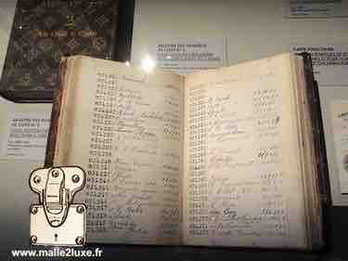
The date of manufacture has only a very small impact on the value of a Louis Vuitton trunk. The age of the trunk does not necessarily increase its value, it is even the opposite:
- A gray Trianon trunk from 1870 will have an archaic construction and therefore less value than a more accomplished 1920 trunk that respects the brand's standards and image.
- On the other hand, a trunk from 1920 is more valuable than a modern PVC canvas trunk today.
THE DIMENSIONS

Apart from a few special cases such as the flower trunk , the rule is rather simple and logical: The larger the trunk, the more expensive it is. A mail trunk therefore costs less than a wardrobe trunk but more than a cabin trunk.
BAGGAGE CONDITION
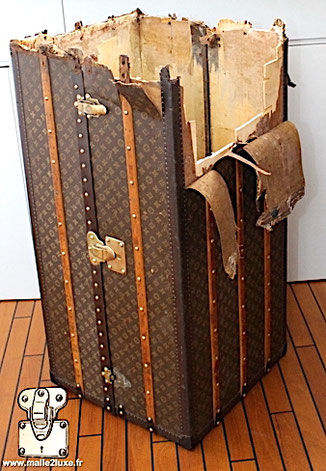
This is one of the key factors, the more restoration work required to restore the original state , the lower the price will be.
For this reason, the same Louis Vuitton trunk can be worth between €1,000 and €5,000 depending on its condition. Only trunks in perfect condition have valuebecause a restoration costs from 3,500 euros for a simple cleaning to more than 15,000 euros for a major restoration as in the case of this partially destroyed wardrobe trunk restored in our workshops.
RECOGNIZE A GOOD FROM A BAD RESTORATION ON A TRUNK?

Of course, if possible, favor trunks in perfect original condition. But unfortunately, the states of origin are increasingly rare, because these trunks have travelled, been badly stored, sometimes mistreated. It is therefore common to have trunks that have undergone one or more restorations.
Because there is no state diploma " antique dealer " just like " Restorer of trunk " for this reason the profession is plagued by converted handyman. Without any technical background or knowledge of traditional know-how and out of greed, to give a little shine to the objects, do irreversible damage to our trunks. Be wary of autodidacts, youtubers, volunteers, collectors and municipal museums, each has their own job. At Malle2luxe we have more diplomas and years of cumulative studies than a doctor surgeon.
A good restoration is a restoration in the rules of the art, which keeps the authenticity of the trunk and its history, it is a real added value of the object. It must be consistent with the existing one. To erase the accidents of course, without deleting its history. Over clumsy treatments and restorations. Very often, in fact, it is by believing that they are doing the right thing that this collectible baggage is distorted. The aim of the restorer is to return the damaged object to a healthy state., while remaining faithful to its history and preserving the patina acquired over the years. The Restoration of trunk is to go in search of an authenticity that is sometimes lost. We know the history and use of each historic trunk maker in order to best respect the history of its collectible luggage.

Today, three principles govern the work of restoring collector's trunks:
- The restoration must respect the choice of materials in accordance with the years of manufacture of the luggage.
- The restoration must be perennial made with traditional techniques , those which best respect the object and will hold in time.
- The restoration must be reversible
As you will understand throughout this article, not all restorations are of the same value, whether they are preventive or curative. Respect for the finishes which are the result of the expertise of the trunk maker are the key to a beautiful restoration.
VALUE ACCORDING TO FINISH (SERIES):
The finish, also called series, represents the different versions of Louis Vuitton trunks, in other words the choice of materials that dress the trunk. The more brass, the more luxurious and therefore expensive it will be. Steel (tinplate), on the other hand, will lower the price of luggage. The lozines must be in perfect condition.
| Finish | Series | Score out of 10 |
| Explorer | Metal | 10/10 |
| Leather and brass | 9/10 | |
| Clear lozine | 1 | 8/10 |
| Dark Lozine | 2 | 7/10 |
| Upper Moorish (moresque) | 3 | 7/10 |
| All Leather | Cow | 6/10 |
| Vuittonite Color | Vuittonite | 5/10 |
| Moorish (moresque) | 4 | 5/10 |
| Black Vuittonite | 6 | 4/10 |
| Lower | 5 | 2/10 |
| 1/10 |
OLD TRUNK BRASS
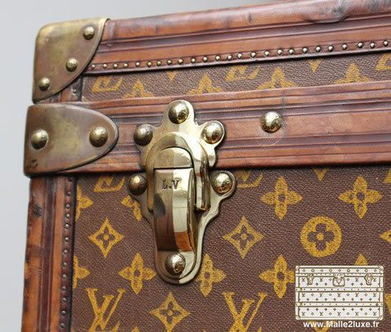
The more the brasses are oxidized the more work there will be to find the original state and therefore a discount applies, but if your brasses have been brushed an even greater discount will apply because they will be very complicated to find a original finish without mentioning irreversible damage. Indeed in terms of polishing we see everything and anything!
Definition : Polishing is the action of polishing: treatment that makes a surface smooth and shiny. Aiming to achieve a beautiful appearance, beautiful shine, high quality surface finish.
We are going to reveal to you how to recognize a good polishing of brass. It is clear that 95% of the polishing on second-hand trunks sold by antique dealers or second-hand dealers are of very poor quality. On a simple photo it is very difficult to see if the polishing is carried out according to the rules of the art , or if it is massacred with a brush. Because you have to see the reflections from several angles and play with the light.

However, certain details will help you to quickly detect bad polishes. Keep in mind that luxury trunks are small series products made with the greatest attention , by exceptional craftsmen, concerned with detail and quality, just like collectibles:
- Prestigious watches Rolex, Patek philippe...
- Collectible cars Rolls Royce, Ferrari ...
- High jewelry Cartier , JAR Rosenthal...
- Silverware renowned Gustave Keller, Christofle...
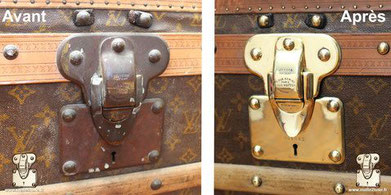
Even if these objects are old, even if there is a certain charm in having an object in ruins , it is inconceivable for a collector to own a precious, luxury object, scratched by an inadequate restoration, not conforming to the origin. ! Example of a polishing on a very oxidized brass because never cleaned. Perfectly successful surface polishing, carried out in our workshops . A good polish is a golden yellow brass , shiny mirror polished, with beautiful reflections

Brass at Louis Vuitton has always been brilliant. The initiative to tune the trunk , by brushing it, making it red or otherwise... is not original. Example of a Louis Vuitton brass during the manufacture of a trunk in the Louis Vuitton workshops in Asnières.
HARMFUL TECHNIQUE:

The following techniques are detrimental to the price of your collector's trunk:
For the sake of economy and time, and often out of ignorance, many restorers and dealers use non-traditional techniques to revive brasses. These techniques unfortunately cause damage to these surfaces.
NYLON BRUSH:

The use of wire brush , nylon, brass . These brushes intended for stripping old paint on metal are highly detrimental to the brasses of your trunks. Indeed, the use of a brush to revive brasses can:
- On the one hand damage the cloth adjoining the part to be polished.
- On the other hand deforms the piece, by breaking the edges which make the finesse of the object and by rounding the whole shape of the object (we call this: "potato effect").
- This reduces the depth of the engravings because the brush "attacks the material" by removing it.
- But above all the brush will deeply scratch the brass by forming furrows in the material (as plowed). It will be very hard to re-level damaged surfaces as a result of this damage.
The removed material can no longer be added, it's a real loss, a discount for a collector's trunk! The marks left by a polishing with a wire brush are recognizable by the blurred reflections. Original luxury trunks have shiny polished brass. The novice initiative to brush the brasses is more akin to tuning than to restoration. And you can't really call it polishing.
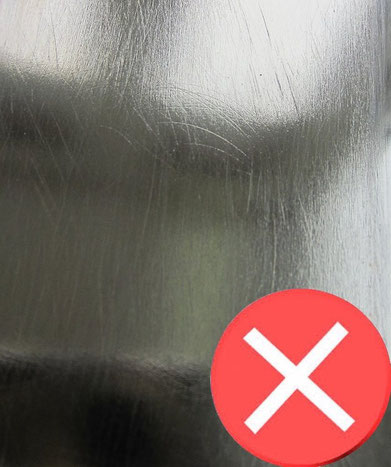
There will be the shiny side but we will lose the smooth side essential to a shiny or mirror polish. The brush removes 0.2 to 0.8 millimeters of material depending on the brushes used. The real know-how of the polisher is to sublimate by removing as little material as possible, just removing the oxidation is in hundredths of a millimeter (0.01 millimeter).
Example of marks left by wire brush polishing.

Example of brass brushing. Recovery of surfaces in our workshop.
As a result, the brass parts are not deformed, the edges and engravings remain perfectly legible... The brasses will regain their brilliance as on the first day even after 100 years of oxidation!

Some small impacts due to these many trips remain present because we remove the minimum of material. We are not trying to make them disappear, they are part of the soul of Louis Vuitton luggage. The trunk returns to its original state before its last trip . Example of a quality polishing done in our workshops. Conversely, adding scratches made by the brush adds nothing to the history of the trunk and makes it lose value.
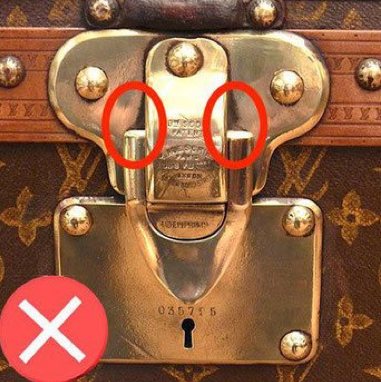
Example of a lock whose surfaces have been massacred with a brush:
- Deformed surfaces
- deep scratches
- Engravings on the nails erased
- Remains of oxidation in the recesses and around the nails
- The adjoining canvas is damaged and stained by the brush.
It's a real loss for the trunk
Tip - Stain in the corners of the lock:
Flee this kind of restoration which says a lot about the amateurism of the seller. It is important that the polishing is carried out over the entire surface, even in the recesses.

CLEANING PRODUCT :
- Use of maintenance product :
"Magic mirror" household products are often used.
The greasy formula of these products stains the leather and leaves a whitish deposit on the fabrics, this damage is irreversible on the fabrics.
- Use of acid :
Hydrochloric acid-based brass cleaners corrode and often leave irreversible marks on canvas or leather.
- Varnish the brass:
The varnish will slow down the oxidation but will be very delicate to remove without degrading the brass. Wax or oil is ineffective, they will just tarnish the brass by breaking the shiny effect and will be complicated to remove .
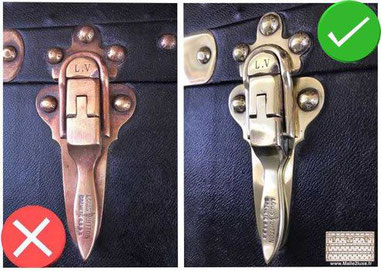
Brass is an alloy composed mainly of copper and zinc. The chemical reaction of the acid on the brass corrodes the zinc, bringing out the copper entering into the composition of the brass. The result is a brass with an uneven reflection. Even after polishing, it will therefore be very difficult to remove these traces and restore the golden yellow color of the polished brass.
Example of a Louis Vuitton car trunk, whose brasses are treated with acid. After restoration and polishing of the brasses in our workshops.
MAINTENANCE OF BRASSES TO KEEP BEAUTIFUL REFLECTIONS

Important : The better the polished surface is executed, the easier it will be to maintain your brasses and preserve their luster and shine. A brushed brass will not be able to maintain the same appearance.
The oxidation of the brass of the trunks is inevitable , they will inevitably turn brown , it is in its nature. There is no solution that lasts and will keep the brass of your trunks shining. Except of course the gilding. The gold would protect the brass from oxidation, but each piece would have to be disassembled, immersed in baths and the brass would lose its shades of color, then becoming uniform, as if frozen.

Because there is no miracle, the one and only solution to keep a shiny brass is to clean it regularly with a soft cloth and a suitable maintenance cream. Each of our trunks is sold with a tube of cream for brass maintenance
Professional brass maintenance kit : Available on the shop
INTERIOR

The interiors of the trunk are covered with cotton and linen canvas, a very fine, tightly woven canvas with a satin finish. At the time, the interiors were glued with rabbit skin glue or fish glue, this explains the rise of glue which forms brown spots, in case of humidity. The quilting is not made of the same fabric as that which covers the barrel.
The trunks being hermetic, the interiors are very often damaged, because they keep all the humidity. A good restoration is a restoration in conformity with the existing one, an informed eye should not be "shocked" and say to himself "this trunk has been redone, because the interior has nothing to do with the whole".

The most common errors of bad restoration are: Use of an inappropriate canvas.
- The canvas of the old trunks is glued over the entire surface.
- Exposed staples and nails to hold a canvas taut are common DIYs. They are often amateurs who restore themselves, instead of calling on an upholsterer.
- Use of synthetic canvas such as suede which is a canvas imitating suede (inner layer of the skin, it can be associated, by synonym, with velvet skin, suede, soft to the touch, matte finish), it is therefore an imitation -leather based on plastic polyester, used in trunk interiors from 1975. It is common to see it in old trunks from 1900, this totally distorts the object.
This technique is common on worthless trunks. It's more boring when the trunk is a Louis Vuitton, a Goyard, a Moynat. Very far from the existing one, this is a discount on a luxury trunk, because the interior will have to be completely redone.
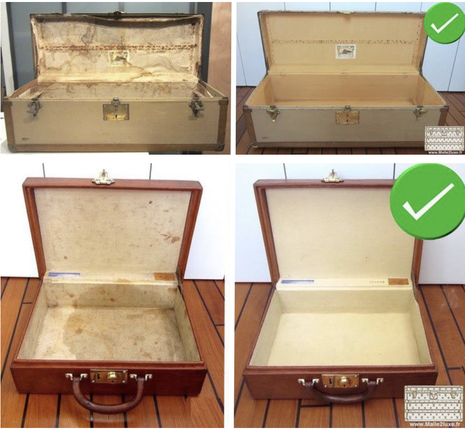
Example of two original restorations :
- Automobile trunk from 1900 restored on behalf of Maison Moynat , the interior patina has been preserved, so as not to erase its history.
- Louis Vuitton suitcase leather exterior. Beige canvas interior, a classic. Restored identically. The materials are identical, the techniques used also.
PADDED OLD TRUNK

The padding was intended to protect the contents of the trunk. It is a very important element in a trunk interior. The secret to a beautiful quilting is volume, straight ribbons and diamonds, all of the same size. The nails connecting the ribbons have domed solid brass heads. The original ribbons used are of various weaving patterns and various colors. However they are all 100% natural cotton, with matte reflections.
Polyester ribbons from the oil industry therefore have no place in the restoration of a collector's trunk.
Their shiny reflections are very easily recognizable and in very bad taste.

Example of padding accumulating number of errors:
- Lack of volume making it all flat.
- Materials chosen: shiny polyester ribbons, coarse canvas, nails holding inappropriate ribbons.
- Lines that do not form diamonds.
- Golden steel nails (not solid brass)
- Ribbons protruding from the edges.
We had to redo it in our workshops to find the original state.
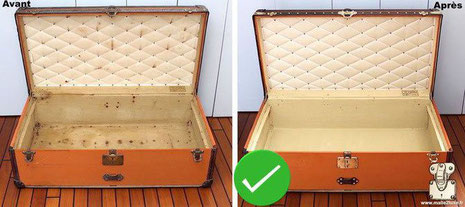
On this trunk in orange Vuittonite where the interior has been restored in our workshops respecting:
- The original materials
- trunk maker's know-how
- period aesthetics.
COATING - CANVAS - MARK

As written in the previous paragraph, the nature of the finishes has a strong impact on the value of the luggage. The coating of the canvas has even more. The rarest and most sought-after coverings are those of aluminum explorer trunks , but these are very rare exceptional pieces.
Regarding coated canvas, the most sought-after are those bearing the famous monogram created by Georges Vuitton , as well as the old checkerboard canvas. There are 3 generations of canvas:
- Woven canvas
- Stencil coated canvas
- PVC coated canvas (plastic)
The production processes of the fabrics and the modes having evolved over the centuries, the specialists are able from typography characteristics to estimate the year of production . Each visible evolution makes it possible to identify editions that we qualify as Mark . Some are more sought after than others and this parameter therefore has an impact on the selling price of the trunk. Many collectors like to own a trunk of each Mark in order to have a complete collection representative of the Louis Vuitton production range:
- A duller canvas - Mark 5 is less valuable than a canvas - Mark 1
- An LV stencil canvas is more sought after and is worth three times more than a trunk with a PVC canvas .
It's all a matter of demand, the Chinese market demands trunks with a PVC canvas while the Western market loves canvas steeped in history and stencilled with a patina.
The trend we are currently seeing is:
In the attached table we compare fabrics that are in perfect condition

Aviator's trunks in copper, stainless steel, brass, zinc or modern replica are very popular with decorators for a "loft / industrial" atmosphere. These are contemporary trunks that are less than 10 years old. Riding the fashion of the collection and travel trunk, they have no patina, no history. It is in no way a collection trunk. For these reasons these trunks therefore have only a very low value between 200 and 500 euros.

|
|
|
Checkerboard - Woven |
Most Wanted 1st |
| Checkerboard - Dark stencil Mark I |
2nd |
| Checkerboard - Dark stencil Mark II | 3rd |
| Checkerboard - Tropical Mark I | 4th |
| Checkerboard - Dark stencil Mark II | 5th |
| Striped - Brown and red | 6th |
| Striped - Brown and beige | 7th |
| Rustic - Brown | 8th |
| Gray - Trianon | 9th |
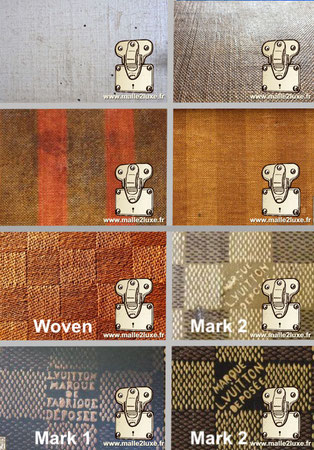

As standard , all travel trunks (luxury or popular, rounded or flat) are covered to protect the contents from dust, insects and humidity. Old trunks are covered with:
- cloth
- leather
- fabrics
- parchment
- paper
- embossed cardboard
- metal
- vulcanized fiber
- ... Etc

There is therefore no curved or flat trunk in raw wood.
Many trunks have been denatured by removing the original canvas to leave the wood visible. There are even forums that explain how to cut canvas and sand wood. Because of this modification, the trunk loses all collection value.

The exterior fabrics are fragile and precious. Contrary to what can be read in some "amateur" trunk books. They are therefore not restored with a stroke of the karcher . The restoration of a canvas is like a painting, it requires patience and meticulousness. IT is important never to apply any product to the canvas, such as varnish, oil or wax. These products will provide instant shine, but in the long run, it's an irreversible disaster. A good restoration consists of restoring the canvas, while remaining faithful to its history, preserving the patina taken over the years.

PRINTED FAUX CANVAS
A new generation of merchant prints canvas
Even worse than the repainted canvas, fake Louis Vuitton checkerboard canvas and fake Goyardine canvas printed on plastic tarpaulin. We have also seen fake canvas printed directly on paper which is then varnished... a plague.
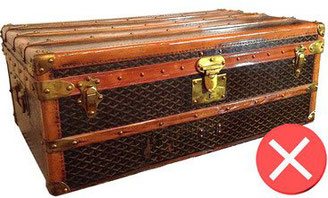
VARNISHED CANVAS - WAXED
On coated fabrics, the application of an insulating product such as wax or worse, varnish of any kind (glycero, polyester, polyurethane, water, resin, etc.) is a disaster. These products trap grime and make restoration or cleaning impossible. The varnished trunks are therefore condemned, and sometimes cannot be restored.
Example with this magnificent Goyard trunk condemned by poor restoration.

REPAINTED CANVAS
The quality of the original canvas on a trunk represents 50 to 90% of the price of a collector's trunk. This practice of partially or totally repainting the Louis Vuitton Damier, Louis Vuitton LV, Goyard, and even Moynat checkerboard canvas is a scourge that we see more and more among less contentious merchants in France and abroad. The state of alert and vigilance is essential. Malle2luxe fights against the destruction of heritage and denounces these practices. Help us protect French heritage.
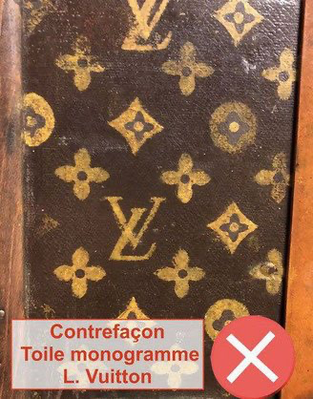
It's a discount of -50% to -70% and making the trunk very hard to resell. Worse than the varnish, the " repaint " which is also called re-tinted, re-pigmented, re-colored, re-coated... In short, the canvas has been repainted! One of the most devastating irreversible techniques on the collectible market. Just like the repainting of old Rolex, Omega, Breguet, Patek Philippe watch dials. It is to kill the soul of the luggage, by removing any patina from it.
Beware of repainted canvases, none are spared:
- trianon
- United "Vuittonite"
- Striped Vuitton
- Checkerboard Vuitton
- Checkerboard Moynat
- Monogram LV
- Monogram Moynat
- Goyardine
Example of a repainted canvas that loses all collection value:
- Repainted monogram canvas that can deceive many buyers
- Monogram canvas; The bottom is cracked but the logo appears like new
- Red checkered canvas has never been entirely repainted.

Example of a partially repainted striped Louis Vuitton trunk.
Beige / Red striped fabrics being rarer. The red stripes have been repainted over the original beige ones. The original is dark beige/red and not light beige/red.

Tip :
The striped canvas is a woven canvas, so it cannot be coated, if coated it means that it has been repainted.
Example of an original striped canvas trunk, a fine collector's item.
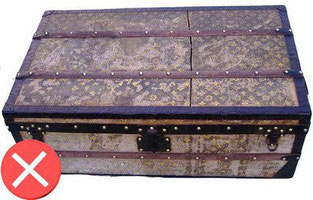
Another condemned cabin trunk , the trunks whose canvas is "bitten" by the humidity. This kind of trunk is often "repainted". On the collection value, a damaged canvas is an 80% discount. Example of a "quilted" Louis Vuitton canvas.
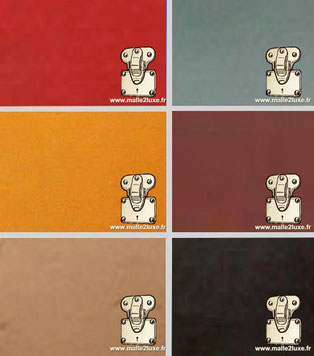

We estimate that 60% of plain trunks sold by merchants are partially or totally repainted , hence the importance of being extremely vigilant. The vuittonite coated canvas, existing in multiple colors. This original canvas grain "shagreen" reminiscent of the grain of leather. Paint can dull the grain of the canvas. It is easy to see the repaint by "black light" lamp.
Example of original unpainted orange vuittonite coated canvas.
EXAMPLES OF REPAINTED CANVASES:


A heavy discount is then to be expected on these trunks to be restored. A "fuzzy" black leather with a marbling effect is a clear sign that it is leather in an " advanced state of putrefaction " which must be changed. Some leather trunks are too damaged.
For example for this trunk, it will be necessary to replace all the leather, which is a heavy and expensive restoration, sometimes more expensive than the price of the restored luggage. These trunks are condemned.
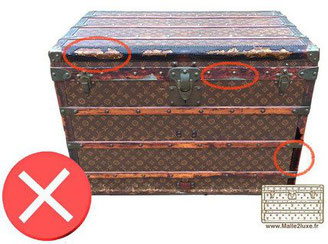
Leather is a noble material. It is also a natural material, alive, very fragile and delicate. It does not support humidity and many trunks and suitcases are damaged. Trunks with leather trim are the most sought after. They still have to be in perfect condition. Cracks, lack of leather, cracks, There is no other alternative than to replace the leather.

Replacing a leather element is an important restoration because they are fixed by hundreds of nails that will have to be removed. It will be necessary to sheathe these elements with leather and rivet everything as originally. The choice of leather, like the hot stampings are essential in order to be faithful to the origin and to patinate it to obtain the perfect color. This is the only solution to preserve its heritage and pass it on.
Example of a partial repair of the leather on this Vuitton wardrobe trunk.
Leather has always been used for its extraordinary mechanical properties. But the characteristics of it can be altered over the years. It is common for the handles to be torn off, broken.
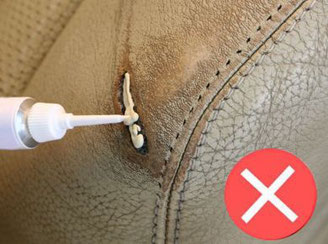
Some unscrupulous restorers mix acrylic silicone with leather powder to create a tab and fill in the holes and lack of leather. A misery cache is, of course, DIY. So be careful to inspect the leathers of the trunk you are looking for.

"Cheap" handle in sheepskin leather (sheepskin)
It is a very low-end "soft" leather, these handles are easily recognizable by its poor quality seams (machine stitching) and the non-existence of the marking border like the originals. With a low-end finish.
Miscellaneous examples of non-original grip.

Many times we have seen seams called "saddle stitch" but which are obviously not. These points are reserved for the neophyte. Here are some examples:
A: Backstitch
B: Double front stitch
C: Unnamed
These seams are not seams, at best handmade lacings made outside the rules of the art and without comparison with the saddle stitch.

At Louis Vuitton, Goyard and Moynat the handles are in vegetable tanned cowhide (VVN), decorative hot stamping. Thick handles.
Some examples of several handles made in our workshops to restore collectible luggage. Hand sewn, weathered and aged to fit perfectly.



Lozine
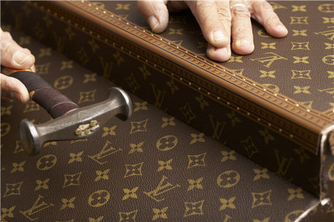
Lozine: Material obtained by stratification of cotton and cellulose fiber, after passing through a bath of zinc chloride and sulfuric acid. The fluid is extracted by pressing, which makes it possible to bind the different fibers together without adding binder. Thanks to this process, the lozine has extremely high mechanical strength, flexibility and stability, combined with low weight. Perfectly insulating, the lozine guarantees perfect sealing of the luggage. Modern lozine Louis Vutton... read our article dedicated to the lozine

Example of an unrestored lozine from an old Louis Vuitton Louis Vuitton trunk. They exist in several colors according to the series and according to the eras, with different markings. Some first black series are unmarked.
Check that they have not been repainted.

Not to be confused with flexoid - Oil resistant jointing.
Sold by some as lozine, this product is used in the automotive industry for its resistance to engine oil impregnation. Paper fibers impregnated with a gelatinous binder and plasticizer, low cost around 9 euros / M2
This modern low-end product has no place in the restoration of old collection trunks.
TRUNK REPLACEMENT PART
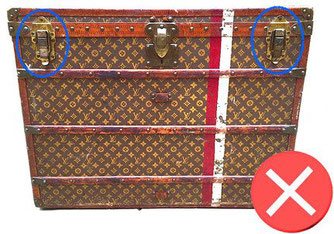
In the long list of possible discounts is the replacement of original parts signed by the manufacturer.
Example on this Louis Vuitton trunk,
or the clasps have been replaced by a generic spare part.
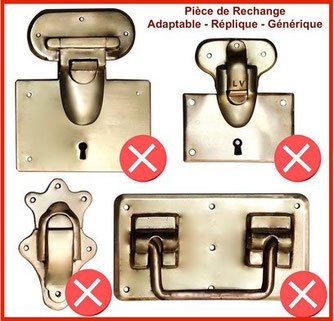
The "generic" pieces of modern manufacture are ideal for making your decorative trunk. But those spare parts, which design is not the original one.
Please note that there are also copies reproduced without agreement with the brands, they are not authentic and the quality is different from the original. These copies are detrimental to the rating of your collector's trunk .

As in the middle of the restoration of furniture and antiques. The restoration must be done with traditional techniques, sometimes slower, but more reliable, because they respect the object better. For example, the use of visible or hidden screws is excluded. This is incompatible with the know-how of traditional trunk makers.
These techniques considerably devalue the value of the trunk.
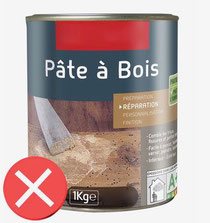
During a restoration, the use of resin glue and other modern chemicals is to be avoided. The materials and products used must be in accordance with the year of the luggage to be restored.
Wood filler fills holes, cracks but will not strengthen the barrel or wooden slats. Only a structural recovery, the purpose of which is to replace the damaged wood, is a lasting restoration. We therefore never use wood putty on the restorations of our trunks.
THEMED TRUNK

And finally to finish, "the Pompon " is to combine bad taste & customization, called "trunk tuning" the discounts are non-respect:
- Original design
- Colours
- Materials
Do not confuse customization with "authentic themed trunk" produced by its manufacturer. Example, this picnic trunk from the 1910s made by Louis Vuitton and of great collector value.
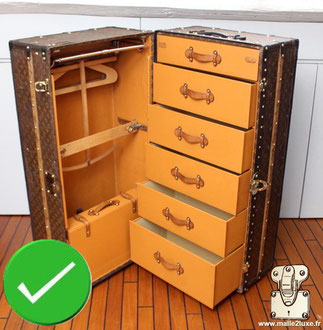
Example of a "themed trunk", made by Louis Vuitton. Interior has been redone in our workshops. Layout conforming to the original, design, color, finish, made with materials of the same nature (leather, coated canvas, wood, nails). This Louis Vuitton wardrobe trunk retains its collection rating. Discover this restoration.
frankenstein
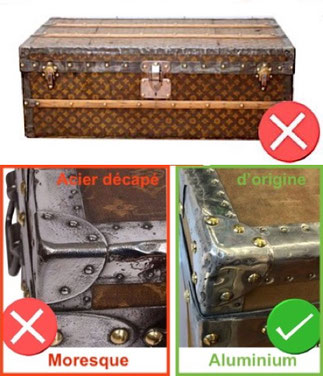
All the STEEL parts (corner, bracket, lock, clasp, border, roller...) of a Louis Vuitton trunk are lacquered in black or gold, there are no raw or polished parts because the steel will rust.
More and more often, bad sellers customize their low and mid-range Moorish finish Louis Vuitton trunks to make them look like high-end aluminum edge finish trunks.
It is a customization that consists of brushing the steel to remove the original black lacquer and reveal the white metal.
In the first case we are on the "low-end" Moorish version of the brand, in the second in aluminum it is the "ultra high-end" aluminum version. Brushing is detrimental to the rating of your trunk, as is customization, which distorts the original condition

This Alzer Louis Vuitton suitcase that has been fitted with wooden slats to look like a trunk . This modification completely devalues the suitcase.
ASSEMBLIES OF REAL PARTS

Called Frankenstein, this trunk is an assembly of real pieces from different periods (lock, handles, clasps), with new PVC canvas. No collectible value. There is no Louis Vuitton trunk with leather trim and steel corner.
LABEL TO HIDE DEFECTS

Another example of a customized trunk, hotel labels, are most of the time real hotel labels stuck on to hide defects, sometimes they are downright fake (printed with a printer). Increasingly used by merchants. The labels are rare and never in good condition, because screen-printed on low-end paper, the color tarnished and the paper does not support humidity (reversible glue like postage stamps). There are almost never any on the front of the trunk (lock side), nor on the back. They are found mainly on the sides and sometimes on the top in small numbers, but very very rarely.
We find that 70% of the labels are added, to facilitate the sale , by hiding defects, or just to invent a story.
PERSONALIZATION:
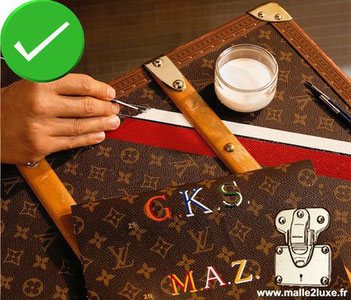
The personalization of the canvas with colored bands has been used since the appearance of the first Louis Vuitton, Goyard and Moynat luggage. This allowed its owners to quickly locate their luggage on carts, cars, stagecoaches, cruise ships, station platforms...
Similarly, personalization with initials, logos, coats of arms and crowns does not reduce the value of the luggage. They don't win either, unless they prove membership in a famous person, or nobility.
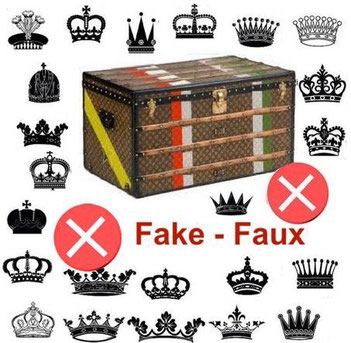
On the other hand when they are redone and not original, they are a real loss.
We estimate that 70% of the so-called "stable" bands on trunks purchased second-hand over the past 15 years are counterfeit.
We estimate that 98% of crowns or coats of arms are counterfeit.
These decorations have the sole purpose of misleading the buyer to create a story for the trunk and make it more "authentic" and attractive. Beware of good stories...

Example of a painting on a modern trunk, independently of the artistic side, this one greatly depreciates this leather trunk.
If modern trunk customization can be elegant, modern customization on old collection trunks to modernize it and make it more attractive for sale is to be banned, often paintings as well as labels hiding defects...
ESTIMATE - EXPERTISE - CERTIFICATE OF AUTHENTICITY - INVOICE
DEFINITION: ESTIMATE
An estimate is free and can be done by anyone. It is not binding, many amateurs engage in this exercise producing estimates which therefore have no value.
DEFINITION: EXPERTISE
An expertise is a paid service that engages the writing, it is not done on photos because the defects are too numerous.
CERTIFICATE OF AUTHENTICITY
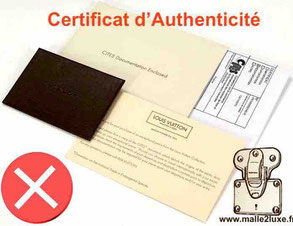
The certificate of authenticity is not subject to any regulations . No law confers any value on it. Just like the estimate, everyone can deliver it. The value of the certificate is based above all on the credibility of its author (competence, respectability, notoriety, link that he may have with the author, etc.). Only a Louis Vuitton certificate would have value. Except Louis Vuitton does not produce any certificate for its bags, trunks, small leather goods...
So if a seller offers you a certificate of authenticity or worse to make you beware, he will not guarantee that the item is not a Louis Vuitton Counterfeit.
BILL

Buying with an invoice , and not paying cash, there are many scams as you will discover throughout this article. The invoice protects you in the event of a stolen object, and will allow you to better resell your trunk if the seller has a good reputation on the luxury trunk market. This invoice on the other hand does not guarantee the authenticity of the trunk, nor the good restoration. Because not all sellers have a good reputation, beware especially of those who offer certificates of authenticity and free estimates, both of which have no value.
WHERE TO BUY A LOUIS VUITTON TRUNK?

Expert advice on Louis Vuitton trunks. Our clients benefit from an exclusive advice service FREE OF CHARGE . Our customers have the possibility of sending us photos of trunks that they wish to acquire (seen with colleagues, in the auction room, etc.) in order to benefit from a reactive advice service to enable them to constitute a prestigious collection of quality. We buy your trunks at the best prices.
WHERE TO SELL YOUR TRUNK
We are in the best position to buy your Louis Vuitton, Goyard, Moynat trunks , whatever the condition.

*These observations contained are the conclusions of results in auction rooms around the world, the opinion of experts and collectors of old luxury trunks.
Expertise : page en francais
Copyright © 2008-2025 Malle2luxe Paris. Tous droits réservés.
















